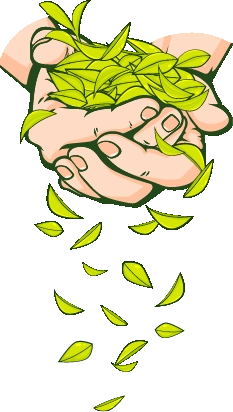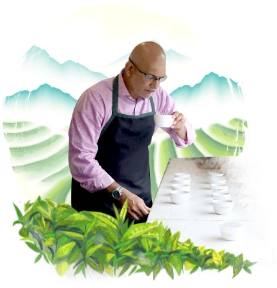Unravelling the Tea Taster’s Jargon
Imagine stepping into a tea tasting room when a ‘batch’ is being tasted by professional tea tasters. Besides the loud slurping (which would be considered downright rude outside the tasting room) and spitting, the cryptic and confusing words uttered by the tea taster would leave you totally bewildered. You would be wondering how a humble tea leaf would be ‘harsh’ or the beautiful golden brew ‘nutty’!
Needless to say, there is a proper ‘tea tasting terminology’ that lists words describing each aspect of tea : the dry leaf, the infused leaf and the liquor. If you closely observe the tea taster at work, you will notice that he will closely inspect the dry leaves and then ‘feel’ them with his fingers. He will then sniff the infused leaves before going on to take a quick, sharp slurp from the bowl, swishing it around in his mouth, and then spitting it out into a ‘spittoon’. He then describes the leaf, infusion and liquor using the typical tea tasting terms, before moving on to the next.
Black Tea is manufactured either by the Orthodox method or the CTC method. The Orthodox manufacture results in leaf teas and the CTC manufacture results in granular tea or pellet-like teas.
In this blog, we will learn the tea taster’s jargon and look at the most common terms that are used to describe the dry leaf of a Black Tea. From appearance and size to texture and color, here are the typical terms that a tea taster uses to describe a Black Leaf tea :
TERMS DESCRIBING DRY LEAF
BLACK: A black appearance is desirable, preferably with “bloom”.
BLOOM : A sign of good manufacture and sorting. A “sheen” which has not been removed by over-handling or over-sorting.
BOLD : Leaves that are too large for the grade—used for both Orthodox and CTC manufactured teas
CASE-HARDENED: Hardened outside but soft inside, caused by quick and hard fire – not good quality
CHUNKY: A very large Broken grade in Orthodox manufactured tea, usually used to describe tips.
CLEAN: Devoid of fibre or stalk, denoting a well-made tea
CURLY: Well-rolled and curled whole leaf in Orthodox manufacture
EVEN : Same-sized leaves, usually denotes good sorting
FLAKY: Open and flat leaves, light-weight – avoided by packers and blenders
GOLDEN TIP: Pubescent buds – most sought after for best quality Assam Orthodox teas from the famous second flush harvest
GRAINY : Describes the grain-like, even-sized leaves in CTC teas
GRAPE NUTTY: Usually used to describe CTC teas that are not completely smooth
GREY : Rough handling during sorting, caused by abrasion which is undesirable
GRITTY : Used for CTC teas that feel sharp and jagged to touch
LEAFY : Light-weight and low density, normally caused by open and flaky leaves
MUSTY : Tea affected by mildew, a white fungus that can grow on tea leaves
MUSHY: Usually denoting high-moisture content in tea, normally a sign of bad packing and/or storage
OPEN : Not well-twisted or well-rolled
PALE TIPS : The paler colour of tips as compared to Golden tips, and hence, less valuable
STALK & FIBRE: Denotes poor plucking, usually consisting of stems and rough leaves, resulting in inferior-quality of tea
STYLISH: Well-made, well-rolled, even and neat leaves
TIP: The bud of the bush, silvery or golden in appearance, it is highly desirable in Orthodox grades, and denotes fine plucking
TWISTED: Highly appreciated in Orthodox whole leaf grade, signifying excellent rolling – also known as well-made or well-rolled
WHISKERY : Long fibre, best avoided
WIRY: Thin and delicate, well-twisted Orthodox whole leaf that is most sought after
After the dry leaf, the tea taster normally takes a quick look at the infused leaves – gently pressing them with his fingers, and occasionally, sniffing them. Unlikely as it may sound, to a professional tea taster, the infused leaves reveal a comprehensive insight into where the tea was grown, when it was harvested, how it was plucked and how it was manufactured.
TERMS DESCRIBING INFUSED LEAF
AROMA: Smell or scent denoting the character of the tea – usually further classified as vegetal, sweet, nutty, toasty, etc. Also, sometimes referred to as ‘nose’
BISCUIT: A fresh aroma, toasty and sweet, often found in a well fired Assam teas
BRIGHT: A vibrant and lively appearance indicating a well-made tea
COPPERY: Indicates an excellent ‘bloom’ and a sure sign the tea is from peak summer/second flush harvest in Assam – particularly sought after for second flush CTC teas
DULL: Undesirable lacking brightness, normally associated with poor manufacture or high water content in the leaf
DARK: A dark colour normally due to poor leaf quality
GREEN: Undesirable in Black teas, this is due to either immature leaves or under oxidization or in some cases due to bad rolling in Orthodox teas
MIXED: Indicates poor tea of differently coloured leaves – not desired
TARRY: A distinct but undesirable smoky aroma – indicative of faulty firing due to high temperature or bad materials used to fire the dryer
Finally, the tea taster will take a long, loud slurp of the liquor. He will swish and swirl it in his mouth a few times before spitting it out. In those few moments, he would have noted the taste, astringency and flavor notes of the tea, which he would then describe.
TERMS DESCRIBING LIQUOR
ASTRINGENCY: The puckish feeling that you get when you drink good wine – causes dryness in the mouth. Not to be confused with bitterness or pungency!
BAGGY: An external taint usually due to unlined Hessian or Jute bags used in packing
BODY: Robust and full liquor as opposed to thin liquor
BAKEY: Overfired causing more than desired moisture to be removed
BRIGHT: High desirable quality that can come only from good manufacturing
BURNT: Excessively baked in the dryer
COARSE: Opposite to brisk teas, these are generally secondary CTC dust teas
CREAMY: Teas with a distinct layer of precipitate after cooling – a sign of good tea
FLAT : No briskness or strength, normally due to aging
FLAVORY : Excellent flavour, highly desirable in high-elevation teas and particularly teas from Darjeeling
FRUITY : Over oxidized or over fermented, usually to be avoided, except in the case of summer flush teas from Darjeeling, where a fruity character is highly desirable
GONE OFF: Teas that are flat, normally due to being old and acquiring undesirably high levels of moisture
GREEN: Teas with unpleasant ‘rawness’ caused by under-withering or under oxidization
HARSH: Unpleasant taste from immature tea or tea made from coarse leaves or due to wrong oxidation and drying
MOULDY: Heavy tea with a clear moldy smell, either damaged by water or gone off due to age
PUNGENT: Typical of good quality teas from Assam with balanced astringency, briskness, brightness and strength, similar to Lapsang Souchong tea from China
SMOKEY: Teas with distinct smoke flavor, usually not desired except in cases where teas are deliberately smoked over pine or cedar wood fire to create a distinct woody smokey note
STRENGTH: Robust and malty cup with good thickness and texture
THIN : Lacking in body, caused by bad manufacturing
WILD : Undesirable character typically found in end-season teas
The jargon of a tea taster actually unveils a world of sensory exploration. By understanding the terms used to describe the size, appearance, texture, color, and fragrance of the dry leaf, tea enthusiasts can gain deeper insights into the potential flavors and brewing characteristics of their favorite black teas. Exploring these descriptive terms not only enhances the understanding of black tea but also adds an extra layer of enjoyment to the overall tea-drinking experience.
So, the next time you prepare a cup of black tea, take a moment to observe and appreciate the intriguing nuances offered by the dry leaf, allowing yourself to savor the complexities in every sip.

Tea is a religion in the art of life.

